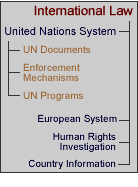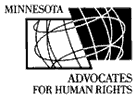|
|
|
ENFORCEMENT MECHANISMS IN THE UNITED NATIONS When a nation ratifies a treaty it undertakes both negative obligations (to refrain from actions that violate human rights) and positive obligations (to take affirmative actions to guarantee that human rights are protected). In order to ensure that governments are fulfilling both negative and positive obligations, the United Nations system includes a variety of enforcement mechanisms. Enforcement mechanisms are usually categorized by the type of UN body that receives communications or carries out the monitoring process. There are three broad categories of enforcement mechanisms: (1) charter-based mechanisms, such as the UN Commission on the Status of Women; (2) convention or treaty-based mechanisms, such as the Committee on the Elimination of Discrimination Against Women; and (3) mechanisms contained in UN specialized agencies, such as the International Labor Organization or the World Health Organization. Each of these bodies monitors either a specific human rights issue or particular treaties. The classification of enforcement mechanisms into these categories clarifies the workings of the UN structure. For women’s rights advocates, however, it is generally more useful to understand the type of procedure available under each of the UN enforcement bodies, rather than the structural aspects of the mechanism. Individuals or non-governmental organizations (NGOs) can bring information about human rights violations, or non-compliance with human rights obligations, to the UN bodies mentioned above through two procedures: complaint mechanisms and reporting/ monitoring mechanisms. Each procedure has its own requirements, limitations and outcomes. In choosing to seek enforcement of human rights obligations, advocates should carefully evaluate, first, the mechanisms available to them based on the treaty ratification of their national government, and, second, the desired remedy or outcome for the victims of human rights violations. There are also specific differences between the procedures, such as whether the communication remains confidential, that must also be considered. Advocates should consider the remedies available at the international level, under the UN, as part of a larger strategy to combat violence against women. For many reasons, the international enforcement mechanisms should only be addressed after attempting to obtain redress through the national legal system. First, the UN enforcement bodies that accept direct complaints require exhaustion of domestic remedies before a case can be considered admissible. Secondly, and perhaps more importantly, the remedies available under international law may not always be advantageous to the individual victim. The UN mechanisms are often very slow and time-consuming and confidentiality of the complainant cannot always be ensured. Victims of violence may have limited resources in which to invest in a lengthy procedure. Furthermore, safety for the victim should be a paramount concern, and the UN is limited in its ability to intervene and protect individual victims of human rights violations. Complaint MechanismsSome UN bodies accept complaints (usually referred to as “communications”) directly from private individuals or from NGOs on behalf of individuals. Depending on the body to which the complaint is submitted, advocates can chose between two types of complaints, each of which serves a different purpose: (1) The complaint-recourse procedure should be used when the victim is seeking redress for a specific human rights violation. The general purpose for submitting this type of complaint is to address individual grievances and advocate on behalf of the victim. The complaint procedure also serves to bring publicity to a specific case. The UN bodies that receive such complaints (for example the Committee on the Elimination of Discrimination Against Women, under the Optional Protocol to the Convention on the Elimination of All Forms of Discrimination) review the submission and can ask the state government concerned to take measures to protect the victim and to provide redress for the violation. Unlike judgments under regional systems, such as the European human rights system, however, the decisions reached by the UN in such circumstances are not binding on national governments. UN bodies do, however, continue to monitor State compliance. (2) The complaint-information procedure functions in a way similar to the reporting mechanisms. The purpose for submitting this type of complaint is to inform the appropriate UN body about broad human rights violations that affect large segments of the population. The Commission on the Status of Women is an example of a UN body that receives such communications about the status of women’s rights. Advocates or victims cannot ask for a remedy when using this complaint mechanism, and the communication itself is only one piece of information that the UN body considers in making a report. In order for a communication, a complaint, to be found admissible under a UN enforcement body, it is necessary to follow standard rules of procedure. Each monitoring body may have specific requirements for the form of communications, many of which can be accessed through the UN website on Communications and Complaints Procedures. In addition, there are some general guidelines that are common to all enforcement bodies that may provide useful information for submitting a complaint. Reporting/ Monitoring MechanismsEach of the three types of UN bodies, charter-based mechanisms, treaty-based mechanisms and specialized agencies, carry out human rights monitoring. In order to enforce the provisions of international treaties, the UN does not rely solely on information about violations of human rights brought by individuals or NGOs. The UN human rights bodies themselves regularly monitor compliance with treaty obligations. Monitoring and reporting procedures differ from complaint mechanisms in that monitoring does not result in a legally binding decision, nor does it depend on information communicated by individuals or groups. When UN bodies undertake monitoring, they create a report on State noncompliance which includes specific authoritative, but non-binding, recommendations. There are two ways that the reporting and monitoring procedure can be initiated: (1) Required State reporting: The six core human rights treaties (the International Covenant on Civil and Political Rights, the International Covenant on Economic, Social and Cultural Rights, the Convention against Torture and Other Cruel, Inhuman or Degrading Treatment or Punishment, the Convention on the Elimination of All Forms of Discrimination Against Women, the Convention on the Eliminations of All Forms of Racial Discrimination and the Convention on the Rights of the Child) establish committees that monitor their implementation. Once a national government has ratified one of these treaties, it is required to report on a regular basis to the treaty-monitoring body. States are under an obligation to report on their own compliance with the treaty, but the committees have no power to enforce this requirement. Thus, it is not unusual for national governments to miss reporting deadlines or to fail to submit a report at all. NGOs have successfully used the State reporting period as a tool for advocacy. Most commonly, NGOs may submit alternative or “shadow” reports which offer an alternate view of State compliance with treaty obligations. Typically, shadow reports elaborate on information contained in State party reports and provide an alternative analysis. Accredited NGOs can also monitor many of the Committee’s proceeding as observers. More information on both the process of writing shadow reports as well as strategies to effectively use this mechanism can be found in the Human Rights Investigation and Documentation section of this website. (2) Committee or NGO- Initiated reporting: Some UN monitoring bodies initiate a report on government action outside of the reporting schedule required by a treaty. In the case of the UN Special Rapporteurs, such as the Special Rapporteur on violence against women, the office initiates analyses of specific issues or developments, which is published in a report. Alternatively, information from advocates and NGOs may bring a specific issue to the attention of a UN body, such as the Commission on the Status of Women, which will then carry out a study and issue recommendations. The role of advocates in the monitoring process is distinct from that in the complaint process. While there is no circumscribed procedure for communications, NGOs have effectively addressed various UN committees during reporting periods to raise awareness of women’s rights. A number of UN committees have indicated that, despite the lack of explicit provisions about NGO participation, committee members rely on NGO information to determine whether State parties are fulfilling obligations under specific treaties. NGOs can meet with committee member working groups during pre-sessional periods and also may make statements to the committees during sessions. Major United Nations Enforcement Bodies There are several UN bodies that are concerned with the enforcement of women’s human rights, through both complaint and reporting mechanisms. Additionally, other enforcement bodies monitor human rights broadly, but will address women’s rights when applicable. The major UN enforcement bodies and the mechanisms available under each one are summarized below. More information is available by clicking on the specific body or mechanism. Procedurally, many of the committees will not consider complaints if they have been submitted under another mechanism. The term “multiple applications” refers to complaints based on the same facts that have been submitted to several mechanisms at close to the same time. NGOs and advocates should consider all available options carefully before submitting a complaint Unlike the complaint mechanisms, however, NGOs are not limited in the number of UN bodies to which they can submit reports. In fact, NGOs should submit relevant information to any and all special rapporteurs, working groups or committees that are reviewing a specific country or rights violation. |
| Home | Contact | Feedback | Disclaimer |

